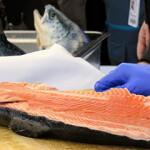Salmon found 42 miles up tributary likely from Cooke Aquaculture escape
More than three months after more than 150,000 Atlantic salmon escaped from Cooke Aquaculture’s pens near Cypress Island, Washington, the non-native fish have been found more than 42 miles up the Skagit River, an important tributary for native salmon, the Seattle Times reported.
On a recent fishing expedition on the river, a crew of Skagit Indian fisherman caught more Atlantic salmon than any other species.
Scott Schuyler, the tribe’s natural resources director said that if they’re finding the fish in the Skagit River, they must also be in other nearby rivers.
After the fish escape, Cooke assured skeptics that the Atlantic salmon would starve and die out, but the ones caught by the Skagit fishermen appeared to be healthy and well fed.
“If they are here, they are in the Nooksack, they are in the Stillaguamish. The Skagit [River] could be like a snapshot for all the rivers around here. We don’t know the full effect of the release, and it will take long-term monitoring to find out,” Schuyler said.
Cooke Aquaculture Vice President of Communications Nell Halse told The Seattle Times the company was investigating the issue.
“I can confirm that we are working with the Upper Skagit Tribe to gain a better understanding of the fish that appear to be Atlantics and their origin. We also had an employee meet with the tribe… to assist in the gathering of information. That meeting was helpful and we continue to evaluate the situation. Our investigation is ongoing so we can’t provide more information at this time.”
Mark Baltzell, Puget Sound salmon manager for the Washington Department of Fish and Wildlife told the times that he believed the fish to be Atlantic, though Halse sounded skeptical. “They look like Atlantics to me. We haven’t had any other escapes, so I wouldn’t have any reason to doubt it.”






Share